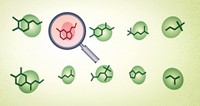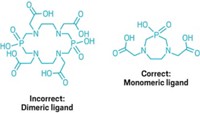Advertisement
Grab your lab coat. Let's get started
Welcome!
Welcome!
Create an account below to get 6 C&EN articles per month, receive newsletters and more - all free.
It seems this is your first time logging in online. Please enter the following information to continue.
As an ACS member you automatically get access to this site. All we need is few more details to create your reading experience.
Not you? Sign in with a different account.
Not you? Sign in with a different account.
ERROR 1
ERROR 1
ERROR 2
ERROR 2
ERROR 2
ERROR 2
ERROR 2
Password and Confirm password must match.
If you have an ACS member number, please enter it here so we can link this account to your membership. (optional)
ERROR 2
ACS values your privacy. By submitting your information, you are gaining access to C&EN and subscribing to our weekly newsletter. We use the information you provide to make your reading experience better, and we will never sell your data to third party members.
Insert Data Here … But Make It Up First
Suspicious note in Organometallics paper may have been embarrassing mistake, or a tip-off to ethical malfeasance
by Carmen Drahl , Stephen K. Ritter
August 9, 2013

“Emma, please insert NMR data here! where are they? and for this compound, just make up an elemental analysis …”
It was an innocent error, or maybe a condemning one. This editorial note by the authors somehow ended up in the published version of a research paper in the American Chemical Society journal Organometallics, released online on July 12. ACS is the publisher of C&EN.
Whether this case turns out to be awkward but explainable phrasing or an inducement to fabricate data, it is yet another object lesson of the yeoman’s work journal editors must do to protect the integrity of their publications and to ferret out bad apples. The incident has lit up the Internet since it was highlighted on Aug. 6 at the Chembark blog, run by St. Louis University chemist Paul Bracher. “The editing staff and the reviews [sic] should have noticed this and it should never have made it to print,” wrote commenter “Neil” at Chembark. Other comments say it appears to be an instruction to commit fraud.
The research in question was carried out by Emma E. Drinkel, Reto Dorta, and coworkers at the University of Zurich. The paper describes studies on the synthesis and structure of chiral palladium and platinum bis-sulfoxide complexes and their activity as enantioselective catalysts for hydroboration and diboration reactions (Organometallics 2013, DOI: 10.1021/om4000067).
In the paper’s supporting information file, which reports details of the syntheses and analytical data, one of the compounds is missing the spectral data and elemental analysis report. The line of suspicious text, floating in the space where the data ought to be, reads as though Dorta is instructing Drinkel to make up results.
Organometallics Editor-in-Chief John A. Gladysz, a chemistry professor at Texas A&M University, jumped on the problem as soon as it was discovered in early August, and he is still checking the editing paper trail. According to Gladysz, the originally submitted paper that was read by an associate editor and peer reviewed did not contain the snafu. It appears that after the paper was accepted and returned to the authors for minor corrections, the authors returned the revised manuscript to the journal’s editorial office but attached an earlier, incomplete supporting information file. That mistake was not caught by the editorial staff before the paper was published online.
Gladysz pulled the paper from the print publication schedule but has left it on the journal’s website while the issue is resolved. Organometallics editors have requested Dorta to submit all of the raw data for the paper so that it can be scrutinized. Dorta, who is now at the University of Western Australia, and Drinkel, who is now at the Federal University of Santa Catarina, in Brazil, are complying with the request. Gladysz says if everything checks out, he will accept the paper and move on.
Dorta has explained to Gladysz that the suspicious statement pertains to a compound that was downgraded by the research team from being an isolated product to a proposed intermediate because there were insufficient data to fully characterize the compound. The compound is a derivative of one of the principal compounds reported in the paper, and as reported in the paper it does not seem suspicious.
However, Dorta did not comment on the meaning of the wording that appears to direct Drinkel to commit a fraud. Dorta maintains that all of the reported data are legitimate, Gladysz says. But Dorta admitted to Gladysz that the statement was inappropriate. Dorta has not yet responded to C&EN’s request to further explain the possibly incriminating sentence in the paper.
Gladysz adds that the decision to keep the supporting information with the error on the Web, at least for the time being, is one of transparency and honesty toward the chemistry community. “I don’t think we should nuke this paper based on the glitch until we have all the facts,” he says.
Many readers have commented that the statement reflects poorly on the moral or ethical character of the authors, Gladysz adds, and they are calling for retribution. “But the broad retribution that some would seek is not our purview,” he asserts. “As editors, our powers are limited to appropriate precautionary measures involving future submissions by such authors to Organometallics.” The details of any sanctions would be confidential as stipulated in the ACS Ethical Guidelines.
“The editor’s statement is certainly adequate, at least to a mathematician,” comments Lance W. Small of the University of California, San Diego, a former council member for the Committee on Publication Ethics (COPE), which advises editors and publishers on how to handle misconduct.
It is still early in the investigation, but Gladysz says there may yet be a smoking gun that proves wrongdoing. Some of the data in the paper are part of Drinkel’s Ph.D. thesis. Gladysz has found some possible discrepancies between the sets of data reported both in the paper and in the thesis.
One issue is whether some of the compounds are solvated or not. In crystalline compounds, special care must be taken in characterizing compounds that crystallize as solvates—that is, with solvent molecules retained in the lattice structure. The problem is not necessarily that there is a solvate, but whether the researchers know they have a solvate on their hands or not. Calculating yield or elemental analysis data without knowing would lead to erroneous results, making the results appear better—or worse—than they really are.
Elemental analyses are a key piece of data that many journals require researchers to submit in addition to X-ray crystal structures and spectroscopic data for any new compound they are reporting. Typically, the researchers calculate the percentage of each element in the compound and compare the numbers with results of an experimental analysis carried out by an independent laboratory.
Elemental analyses can be easy to fabricate and slip into a paper if a journal does not ask the researchers to submit a copy of the independent laboratory report. Fake elemental analyses were a key component in the 2011 case of graduate student Bengü Sezen’s fraud in the work she published from 2002 to 2005 with chemistry professor Dalibor Sames at Columbia University, an infamous case that rattled the chemistry community.
Gladysz wants to double check the numbers before speculating further. “It will take a few days to get to the bottom of it, or to the point where it will be reportable,” Gladysz says. He adds that even if everything checks out, he feels a moral obligation to ensure that this incident isn’t a signal of a bigger problem. He has taken the extra step of notifying the University of Zurich’s vice president of research about the problem and will leave it in the university’s hands to do a broader investigation as warranted.
Meanwhile, Worcester Polytechnic Institute chemist Shawn C. Burdette wrote on Facebook that elemental analysis isn’t the essential measure of compound identity and purity that it once was, thanks to modern instrumentation. The technique still has value when reporting unexpected results, he tells C&EN. It can be a hassle to carry out, however, because not many universities have on-site facilities, which complicates analysis of sensitive compounds, potentially including the intermediate in question.
“I doubt the principal investigator is really trying to pull one over on the journal or the community with bad data,” Burdette says. “He’s looking at the inconvenience of getting the data, and perhaps has little to no faith in the technique for this case, but does have confidence that the chemistry is correct.”
“It’s not the right way to do science, but somewhat understandable,” Burdette continues. “I think there is an opportunity here to talk about reasonable standards, the review process, and scientific integrity.”
“This is an unusual case in the way it presented,” notes Virginia Barbour, chair of the COPE Council and a founding editor of the journal PLoS Medicine. “But questions on data in papers after publication are very common.” Her group publishes procedures for journal editors to follow when they suspect data fabrication. The committee’s advice here, she says, “would be that the journal investigate as far as they are able.”




Join the conversation
Contact the reporter
Submit a Letter to the Editor for publication
Engage with us on Twitter